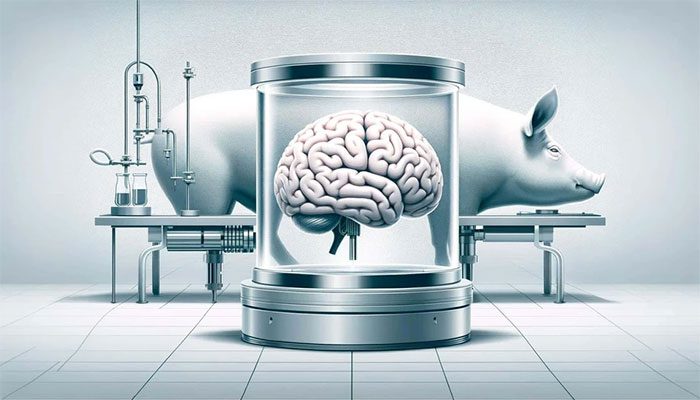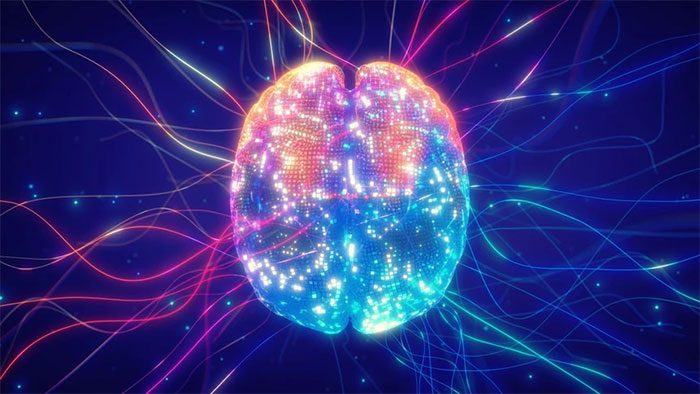A research team has invented a device capable of separating the brain from the rest of the body and simulating blood pumping like a real heart, allowing the brain to be nourished externally for up to 5 hours.
Developed by scientists at the University of Texas Southwestern Medical Center (UT), the system isolates the brain from the rest of the body using a “super-intelligent artificial blood pump”, which takes over the task of supplying blood to the brain.
It is named the extracorporeal pulsatile circulation control device (EPCC) – enabling the brain to receive essential nutrients, oxygen, and blood to continue functioning.

This device will undergo further testing to evaluate its effectiveness in clinical conditions. (Image: DALL-E).
Method of Isolating the Brain from the Body
“This new method facilitates research focused on the brain independent of the body, allowing us to address physiological issues in unprecedented ways,” stated Dr. Juan Pascual, the lead researcher.
In addition to paving the way for research on the human brain without interference from other bodily functions, this study may inspire the design of more complex heart-lung machines that simulate how blood circulates to the brain, similar to the human heart.
According to BGR, the brain is a highly mysterious organ. It serves as the control center for many bodily processes such as heart rate, breathing, and sleep-wake cycles. Thus, it is significantly influenced by various physiological factors such as blood sugar levels, blood pressure, and oxygen concentration.

The pig’s brain remains alive despite being without a body. (Image: Bloomberg).
The development of a device that can isolate the brain from the influences of the body is considered a significant breakthrough. It could be the key to unlocking deeper research into how the human brain functions.
According to a scientific article published in Nature, the EPCC system operates by redirecting the blood supply to the brain through a pump. It can adjust variables such as pressure, volume, temperature, oxygen, and nutrient levels.
This allows researchers to maintain stable brain function over extended periods. The isolation provides precise blood flow to the brain, enabling a better understanding of how blood affects brain function without the body’s interference.
Specifically, Dr. Pascual and his research team utilized this technology to gain insights into the effects of hypoglycemia on the pig brain without relying on the body’s compensatory mechanisms. Theoretically, this approach enhances understanding of how fluctuations in glucose concentration directly impact brain activity.
Furthermore, the EPCC device pumps blood in a rhythmic manner, mimicking the human heart more closely than current heart-lung machines. This method has the potential to minimize side effects associated with brain function that are often related to these machines. With existing patents, this device will undergo further testing to assess its effectiveness in clinical settings.
Strange Experiments with the Brain
In fact, this is not the first time animal brains have been separated from their bodies. One of the earliest experiments was conducted in 1857 when French doctor Charles-Édouard Brown-Séquard decapitated a dog. Ten minutes later, he attached four rubber tubes to the arteries of the dog’s head to inject oxygen-rich blood. A few minutes later, its eye movements and muscles resumed.

Many experiments have been conducted on animal brains. (Image: Adobe).
Even stranger was an experiment where American neuroanatomist Robert J. White separated a monkey’s brain and attached it to the circulatory system of another animal. He called this method whole-body transplantation. White even envisioned that one day it might help paralyzed individuals extend their lives through surgery.
The result was that the monkey survived for 8 days. During this time, it was able to see, smell, and move its mouth, but it could not control its new body. Surgical procedures alone could not connect the monkey’s head to the hundreds of millions of severed nerve fibers in its spinal cord.
However, the recent discovery by scientists at the University of Texas regarding the pig brain has drawn attention because it lays the groundwork for another audacious idea: that a person could potentially live in a foreign body, as long as blood circulation is maintained.
This is certainly not the goal of the research, but it hints at the possibility that one day the method of isolating the brain may be applied to humans.


















































